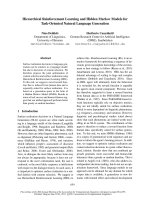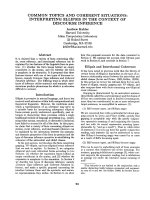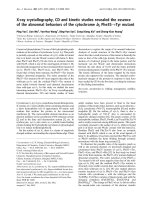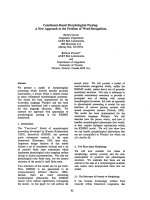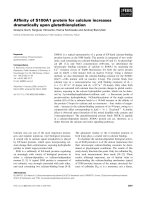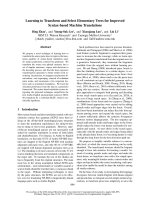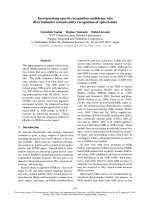Báo cáo khoa học: Affinity purification-mass spectrometry Powerful tools for the characterization of protein complexes ppt
Bạn đang xem bản rút gọn của tài liệu. Xem và tải ngay bản đầy đủ của tài liệu tại đây (210.77 KB, 9 trang )
MINIREVIEW
Affinity purification-mass spectrometry
Powerful tools for the characterization of protein complexes
Andreas Bauer and Bernhard Kuster
Cellzome AG, Heidelberg, Germany
Multi-protein complexes are emerging as important entities
of biological activity inside cells that serve to create func-
tional diversity by contextual combination of gene products
and, at the same time, organize the large number of different
proteins into functional units. Many a time, when studying
protein complexes rather than individual proteins, the bio-
logical insight gained has been fundamental, particularly in
cases in which proteins with no previous functional anno-
tation could be placed into a functional context derived from
their Ômolecular environmentÕ. In this minireview, we sum-
marize the current state of the art for the retrieval of multi-
protein complexes by affinity purification and their analysis
by mass spectrometry. The advances in technology made
over the past few years now enable the study of protein
complexes on a proteomic scale and it can be anticipated that
the knowledge gathered from such projects will fuel drug
target discovery and validation pipelines and that the tech-
nology is also going to prove valuable in the emerging field of
systems biology.
Keyword: TAP (tandem affinity purification).
Protein complexes
In the postgenomic era, proteins are coming back into focus
because it has been realized again that whole genome
sequence information alone is not sufficient to explain and
predict cellular phenomena, as it is largely the proteins that
execute and control the majority of cellular activities. While
the human genome is estimated to contain approximately
30 000–40 000 genes, the corresponding proteome is much
more complex. Events such as alternative splicing of genes
and post-translational modifications generate a highly
diverse set of proteins that could exceed a million distinct
molecular species within a given cell. This molecular
diversity could contribute to explaining many of the
differences between evolutionary distant species that do
not differ substantially in the total number of genes encoded
in their respective genomes. However, within this diverse set
of molecules, it is critical to maintain functional organiza-
tion. It is becoming increasingly clear that an important
level of organization is provided by multi protein complexes
because instead of proteins and substrates colliding in a
diffusion-dependent manner, proteins generally interact
with each other and form larger assemblages in a time-
and space-dependent manner [1]. At the same time, protein
complexes provide functional diversity that is coded by the
contextual combination of gene products. Within a protein
complex, each individual protein may have a particular
specialized function that contributes to the overall function
of the complex. In turn, this specialized function may well be
dependent on the interaction with neighboring protein
surfaces that may lead to e.g. modulation of protein activity
through conformational changes or post-translational modi-
fications. Prominent examples of protein complexes are the
ribosome, the spliceosome and the nuclear pore complex
but many more (and less macroscopic) protein complexes
with more subtle or diverse functions and exemplified by the
many signal transduction pathways have been described
[2,3].
The beauty of studying complexes is that it allows to
place proteins with hitherto unknown roles into a functional
context that is provided by their associated partners, some
of which may have a known function. Even when analyzing
proteins of known function, novel insight can be gained
from describing their molecular environment. Quite often,
proteins participate to more than one complex or do so in
different subcellular compartments which can help to
understand cross-talk between seemingly unconnected cel-
lular activities. The extent to which such functional
connectivities are operating in cells may be best appreciated
by large-scale functional proteomics projects that build
comprehensive interaction maps for proteins and protein
complexes [4,5]. From a simplistic pharmacological point of
view, functional proteomics via the analysis of protein
complexes would contribute to the identification of novel
drug targets, the reconstruction of pathways and help to
understand the mechanism of action and side-effects of
therapeutic compounds.
Correspondence to B. Kuster, Cellzome AG, Meyerhofstrasse 1,
69117 Heidelberg, Germany. Fax: + 49 6221 13757202,
E-mail: or
Abbreviations: PrP(C), cellular prion protein; N-CAM, neural cell
adhesion molecule; TAP, tandem affinity purification;
TEV, Tobacco etch virus; CBP, calmodulin binding peptide;
PMF, peptide mass fingerprinting; MS, mass spectrometry.
Note: web page available at
(Received 13 September 2002, accepted 12 December 2002)
Eur. J. Biochem. 270, 570–578 (2003) Ó FEBS 2003 doi:10.1046/j.1432-1033.2003.03428.x
Analysis of protein complexes
Within the scope of this review, we will focus on summari-
zing the current technical state of the art for the biochemical
retrieval of associated proteins and protein complexes from
cells and tissues as well as their analysis by mass spectro-
metry, for it is this combination of biochemistry and mass
spectrometry that is driving progress in the field of
functional proteomics today. Special attention will be paid
to one major technical aspect dominating both the discovery
and analysis parts of functional proteomics which is the
handling of very complex protein mixtures. A protein of
interest will typically represent only a tiny fraction of the
total protein present in the source material. More than
10 000 different genes might be expressed at the same time
in a single cell or tissue and, as mentioned earlier, diversity
on the protein level is much higher. In addition to the
diversity on the level of primary protein sequence and the
presence of modifications, complexity is further increased
when considering the dynamic range of expression levels of
individual proteins. While some proteins are present in
several thousand copies per cell, others are just represented
by a few molecules. On top of the pure quantities the
availability of proteins for complex retrieval may be much
lower as it is easy to imagine that just a minor percentage
might be in a physiologically active state and possibly part
of several protein complexes.
As an example, the cell–cell adhesion molecule beta-
catenin was originally described to be associated with the
plasma membrane protein E-cadherin which mediates
cell–cell contact [6–8]. Unexpectedly, the protein was
recently also found to bind to HMG box transcription
factors (TCF, LEF-1) which drive the expression of
downstream target genes of the Wnt-signaling pathway
[9–11]. Both interactions are largely independent of each
other and knowledge of both yields information on
different aspects of beta-catenin function. While it is
straightforward to purify the stable and fairly abundant
cell adhesion complex, the identification of the nuclear
transcription factor complex is technically complicated
because the percentage of beta-catenin participating to this
complex is typically very low.
Isolation of protein complexes by affinity
chromatography
The purification of protein complexes has been accom-
plished by a multitude of different techniques ranging from
classical methods such as size exclusion or ion exchange
chromatography to different varieties of affinity chroma-
tography. Following the arguments that have been made
about sample complexity in the previous section, it becomes
apparent that successful approaches will have to include at
least one highly discriminating separation step. This is
typically provided by affinity-based methods. The common
theme of these is the use of an inherent interaction (affinity)
of two biomolecules. If one of the molecules is immobilized
on a solid support, the interacting molecule can be purified
from e.g. a cell lysate along with associated proteins. There
are many different such affinity reagents but we will confine
ourselves to examining those that have proven useful for the
retrieval of protein complexes, notably recombinant pro-
teins, epitope-tagged proteins and antibodies (Table 1). For
more specialized applications, peptides and nucleic acids
have also been used.
Technically, the discovery of interacting proteins is
influenced by a number of parameters. Biochemical deter-
minants include binding affinities between components of
Table 1. Strengths and weaknesses of commonly used affinity approaches for the retrieval of protein complexes.
Approach Pros Cons Typical application area
Immunoprecipitation Independent of cloning
and ectopic gene expression
Cross-reactivity of antibody Preparative IP from tissue
Rapid procedures
(if Ab is available)
Antibody bleeding from column
Not generic (availability of Ab)
Co-IP from tissue culture and tissue
Epitope-tagging Generically applicable approach Ectopic gene expression necessary Complex retrieval from tissue culture
Ability to purify low abundant
proteins/protein complexes
Protein-tag might influence protein
function
Large-scale studies
Stringent biochemical conditions
necessary for affinity purification
to discriminate against
common contaminants
GST-pulldown Generically applicable approach Complex formation in-vitro Protein-protein interaction studies
Ability to purify low abundant
proteins/protein complexes
Competition with in-vivo
pre-assembled complex
Complex retrieval from tissue
Applicable to very weak protein
interactions
TAP Generically applicable approach Ectopic gene expression necessary Complex retrieval from tissue culture
Ability to purify low abundant
proteins/protein complexes
Protein-tag might influence
protein function
Large-scale studies
Physiological conditions
throughout the biochemical
purification
Ó FEBS 2003 Affinity purification-mass spectrometry (Eur. J. Biochem. 270) 571
the complex as well as their stability and solubility during
cell lysis and affinity purification. Biological determinants
such as the cellular expression level and tissue specific
expression pattern of the protein of interest (bait) can also
have a major influence on the choice of approach. Last but
not least, technical limitations imposed by some methods
(e.g. cloning of large cDNAs) also need to be considered.
The classic approach: antibodies
The classic co-immunoprecipitation (IP) experiment using
antibodies is probably the most frequently employed
method for testing whether two proteins are associated
in vivo but the method can also be successfully used for
the discovery of novel interacting partners in a protein
complex [12,13]. In a typical experiment, a protein
complex is affinity captured from cell lysates by an
immobilized antibody that specifically recognizes an
epitope of one known component of the complex. The
retrieved complex is washed extensively to remove unspe-
cifically bound proteins and is subsequently eluted form
the resin prior to protein identification by mass spectro-
metry (see below).
There are several arguments that would favor an
antibody approach. Importantly, antibodies allow the
retrieval of protein complexes from endogenous compo-
nents of cells and tissues which is obviously closest to
resembling physiological conditions as there is no need for
ectopic expression of the bait protein that could lead to a
variety of problems (see section on epitope tagging). In fact,
there may often be no alternative to IP on endogenous
protein as a particular protein along with associated
partners might only be expressed in a specific tissue and
the establishment of a corresponding in vivo tissue culture
model may not always be possible. Given the available of a
good quality antibody, IP experiments are also fast to
perform as no cloning of complex components is involved in
the process.
One limitation of antibody IPs is that an individual
antibody is needed for every bait protein. Whether
antibodies are commercially available or custom made, it
is not easy to predict if the specificity and affinity of the
produced antibodies will turn out to be useful for immu-
noprecipitation. There are some other, more technical,
limitations to the method: Even mouse monoclonal anti-
bodies might exhibit cross-reactivity with proteins other
than the immunogen. In this case several proteins (or
protein complexes for that matter) that are not related to the
bait protein might be precipitated which, essentially, leads to
the generation of false positives. Cross-reactivity of the
antibody aside, very abundant proteins might unspecifically
bind to the resin on which the antibody is immobilized.
These have to be removed efficiently because otherwise the
data will become more difficult to interpret. Specificity is
typically increased by washing the immobilized protein
complex briefly before elution using high stringency condi-
tions (200–500 m
M
salt). However, components that are not
tightly bound (high K
off
) might be lost during this proce-
dure. Although this point is raised in this section, other
affinity approaches will suffer from the same limitation.
Loss of particular components of a protein complex might
be overcome by chemical cross-linking. Schmitt-Ulms et al.
[14] have demonstrated that the interaction of the cellular
prion protein (PrP(C)) with neural cell adhesion molecules
(N-CAMs) can be maintained during an IP experiment by
mild formaldehyde treatment of cells. While chemical cross-
linking is an interesting approach, it is questionable how
soon such methods would be applicable in a generic fashion
[15,16]. Antibody bleeding from the column is another
technical problem that could become serious in the later MS
analysis. Large amounts of antibodies present in the eluate
might mask the presence of proteins of the purified complex
especially when samples are not separated by gel electro-
phoresis prior to MS analysis. Bleeding can be reduced by
cross-linking the antibody to the resin or by specific elution
(i.e. with peptides representing the epitope). In practical
terms, however, cross-linking cannot fully prevent antibody
bleeding and specific peptide elution is often incomplete
which reduces sample recovery.
The generic approach: epitope tagging
Antibodies can be used in a more generic way for the
isolation of protein complexes that circumvents the need for
producing specific antibodies. For this purpose, bait
proteins can be fused to an epitope-tag and an antibody
directed against the tag instead of the bait protein is used for
complex retrieval. As a result, many different cDNAs can be
fusedtothesametaginparallelandcomplexesretrieved
using the same antibody. Often, multimers of the same tag
are used to increase the affinity and accessibility to the
antibody. A variety of different epitope tags (e.g. Myc, HA,
Flag, KT3) have been used successfully in the past and
antibodies against these tags are commercially available.
The underlying advantage of the approach is the high
degree of reproducibility of the results because standardized
technical procedures can be used that do not need to be
optimized for each individual case.
The downside of epitope-tagging is obviously the need to
ectopically express proteins in cells which largely limits this
approach to cell culture systems. Tight control over the
expression level of bait proteins must be exercised as
overexpression might adversely affect the assembly of a
protein complex. In addition, overexpression can occasion-
ally cause cytotoxicity. This might be overcome by use of
sophisticated vector systems in which the expression level of
the epitope tagged protein can be regulated by an inducible
promotor [17]. In addition, the artificially introduced tag
may interfere with protein folding, protein function, or the
ability to interact with other proteins. It is therefore
advisable to create N-terminal and C-terminal fusions in
parallel. Despite some of these limitations, co-IP via epitope
tags is used extensively on a normal lab scale to identify
protein complexes [18,19] but has recently also been
employed on a proteomic scale [4,5].
The generic approach: ‘GST pulldown’
The standard precipitation experiment with the aid of a
recombinant GST fusion protein has been widely used for
the discovery and analysis of individual protein interactions
and, to a lesser extent, protein complexes [20,21]. In this
approach, the protein of interest is expressed in Escherichia
coli as a recombinant fusion protein and immobilized on a
572 A. Bauer and B. Kuster (Eur. J. Biochem. 270) Ó FEBS 2003
solid support. Interacting proteins can then be precipitated
(or Ôpulled-downÕ) by applying a cellular lysate to the
column. An obvious advantage of this method is that it is
robust, easy to use and capable of retrieving even weakly
interacting and low abundant proteins owing to the fact
that large amounts of recombinant protein are present
on the column. However, not all proteins can be easily
overexpressed in a soluble form in E. coli. Furthermore,
interactions that may be dependent on the correct post-
translational processing of the bait protein may not be
provided by the expression system used. Because protein
complexes are formed within cells, the recombinant fusion
protein is in competition with the corresponding endo-
genous component and therefore the complex may not be
retrieved at all because all complex components are engaged
in endogenous protein–protein interactions.
The tailored approach: RNA and peptides
Although antibodies are certainly the most frequently used
reagents for affinity purification, other bio-molecules may
be used for that purpose as well. The application of these is
typically tailored to the particular system under investiga-
tion and thus can be very specific albeit not universally
applicable. Neubauer et al. [22] described the purification of
the spliceosome with the help of biotinylated RNA as the
Ôaffinity-hookÕ into the complex. Spliceosomes are complex
ribonucleoprotein particles that are assembled from several
smaller spliceosomal complexes. The main activity of the
spliceosome is the recognition of splice sites in nuclear
pre-mRNA and to catalyze the accurate removal of introns
and ligation of exons to yield a mature mRNA. The affinity
of the splicing complexes to RNA was used in this approach
for the isolation of the complex. Splicing complexes were
prefractionated by gel filtration and mixed with a biotinyl-
ated pre-mRNA that was subsequently affinity captured on
a streptavidin-matrix. The protein content of the purified
complex was then separated on a 2D gel and analyzed by
mass spectrometry.
An example for the use of peptides as affinity ligands is
the study of Husi et al. in which the isolation of a large
protein complex from the postsynaptic density fraction of
brain synapses is described [23]. The NMDA receptor is
part of the postsynaptic density and known to be
involved in signaling processes related to the regulation
of synaptic plasticity by binding to the adaptor protein
PSD95. This protein contains several PDZ domains one
of which binds to the few most C-terminal amino acids
of the NMDA receptor. This particular feature was
exploited for the retrieval of a PSD95-containing complex
by immobilizing a hexapeptide corresponding to the
C-terminus of the NMDA receptor and subsequent
binding of PSD95 along with associated proteins from
mouse brain preparations.
The large-scale approach: tandem affinity purification
While the aforementioned techniques all have particular
advantages, their individual limitations may render them
less applicable to studying protein complexes on a proteo-
mic scale. Retrieval methods for such applications should
meet a number of important criteria. First and foremost, the
method must be highly discriminating against unspecific
protein background yet retain essential components of the
complex. In addition, the method must be generic in the
sense that all bait proteins must be processed under the same
conditions in order to yield reproducible and comparable
results as well as attaining the required throughput. If an
acceptable level of reproducibility can be achieved, large
datasets generated in this way can be mined for information
that is not necessarily provided by individual experiments
and thus increase the overall insight gained into the system
under investigation.
A method that was recently developed to meet these
criteria is tandem affinity purification (TAP) [24]. The
basic concept of TAP is similar to the epitope tagging
strategy described earlier. The main difference, however, is
the sequential utilization of two tags instead of one
(Fig. 1). First, the ÔTAP-taggedÕ protein is expressed in
cells to form a complex with the endogenous components.
The tagged protein along with associated partners is
retrieved via interaction of the ProteinA tag with immu-
noglobulins that are immobilized on agarose beads. In
order to remove proteins that are unspecifically bound to
the column, the retrieved protein complex is released by
protease cleavage using the TEV (Tobacco etch virus)
protease. This enzyme is a site specific protease that
cleaves a seven amino-acid recognition sequence located
between the first and the second tag. This sequence is only
found in very few human proteins known so far thus
ensuring that components of retrieved complexes are not
themselves cleaved by the protease. In the second affinity
step, the complex is immobilized to calmodulin coated
beads via the calmodulin binding peptide (CBP) tag. This
step removes the TEV protease and further contaminants
that may be present. The CBP–calmodulin interaction is
calcium dependent and, hence, the removal of calcium
ions with chelating agents can be used as a second specific
elution step that yields the final protein complex prepar-
ation.
Aside some of the limitations associated with epitope
tagging mentioned earlier, the two step TAP approach has
several advantages over traditional single step methods.
Probably the most useful asset is the massive reduction of
sample complexity through very efficient reduction of
unspecific protein background. This achievement simplifies
the analytical strategy chosen for protein identification by
mass spectrometry and reduces the need for validating
identified proteins as genuine interaction partners. Strin-
gent purification conditions (high salt or detergent
concentrations) which tend to result in the loss of
associated proteins can be avoided and the complex can
be kept under close to physiological conditions all along
the purification procedure. Owing to the generic structure
of the approach, the results of TAP purifications are
highly reproducible and comparable for different bait
proteins which renders the approach applicable to small-
and large-scale studies alike.
Gavin et al. recently reported results of a large-scale
proteomic study using the TAP/MS method in which 232
distinct protein complexes of the baker’s yeast Saccharo-
myces cerevisiae were identified. These complexes, in turn,
formed a massive network by sharing of protein compo-
nents providing an unprecedented view on the level of
Ó FEBS 2003 Affinity purification-mass spectrometry (Eur. J. Biochem. 270) 573
functional diversity and organization of a eukaryotic cell.
Although most applications of the method have thus far
been described for yeast complexes, the TAP/MS approach
is equally applicable for the retrieval of protein complexes
from higher eukaryotes such as human [4,25] and Dro-
sophila (A. Veraksa, Harvard Medical School, personal
communication).
Protein identification by mass spectrometry
Mass spectrometry is the method of choice for the
identification of proteins in proteomics projects because of
its superior speed, sensitivity and versatility compared to
traditional protein sequencing by Edman degradation. To
date, hundreds to several thousands of proteins may be
Fig. 1. Schematic representation of the tandem affinity purification method. (A) Structure of the TAP-tag. (B) TAP strategy. A protein complex
containing the TAP-tagged protein is purified sequentially by two independent affinity steps on IgG- and calmodulin-containing resins, respectively.
The immobilized protein is specifically eluted in the first instance by protease cleavage (TEV) and in the second step by lowering the calcium-
dependent affinity of CBP to calmodulin. (C) Examples of TAP purified protein complexes from different subcellular localizations of cultured
human cell lines. Bait proteins are marked with an arrow (CBP, calmodulin binding peptide; TEV protease, tobacco etch virus protease).
574 A. Bauer and B. Kuster (Eur. J. Biochem. 270) Ó FEBS 2003
identified within one day from sample quantities in the
subpicomol range whether or not proteins are N-terminally
or otherwise modified. This advance in sensitivity and scope
together with the extensive availability of protein and
nucleotide sequence information has made mass spectro-
metry and biology much more compatible than in the past.
The Ôjoined forcesÕ of sophisticated biochemical and mass
spectrometry approaches are the real driving forces in the
entire field of proteomics today and have enabled research-
ers to embark on studies of much larger and more
complicated systems than previously possible.
Just as much as complexity is an important aspect to
consider when designing a biological experiment, this factor
is also, to a large extent, governing the choice of which
analytical strategy is taken. Gels, liquid chromatography
(LC) and mass spectrometers are all separation devices
(protein, peptide, mass, respectively) that can be used to
break down sample complexity. Combination of two or
more of these methods can attain enormous separation
power, but only the combination with mass spectrometry
generates data that is sufficient for the identification of a
protein. Questions around whether or not a separation step
prior to mass spectrometric analysis is required or which
flavor of MS-based protein identification is appropriate to
use are sometimes not trivial to answer as they largely
depend on the analytical problem to which the technology is
applied. Table 2 may serve as a rough guideline for assessing
the merits of the more widely available MS strategies. In
short, protein separation methods with high resolving
power such as 2D gel electrophoresis are generally well
compatible with MS approaches that have only limited
capabilities for mixture analysis. Conversely, when the
discrimination power of the analytical system is very high,
there is less need for protein separation prior to MS analysis.
As far as protein complexes are concerned, the analysis
typically starts from 1D gels that are used to separate the
components of a protein complex (Fig. 2). 1D gels are
primarily used for this purpose because the complexity of
the protein mixture is normally not extremely high after
affinity purification and the fact that running good quality
1D gels is technically trivial compared to 2D gels. Some
details regarding protein isoforms and modifications may be
lost but that loss can often be compensated for by the
excellent extra separation dimension offered by the mass
spectrometer. Following protein separation, the protein to
be identified is cut from the gel and cleaved into peptides.
Trypsin and Lys-C are most frequently employed for this
purpose because they give rise to fragments that have
favorable physico-chemical properties for peptide detection
and sequencing in an MS experiment, notably the presence
of a basic amino acid at the C-terminus of a peptide. There
is a new trend that aims at avoiding protein separation by
Table 2. Merits of mass spectrometry based protein identification strategies used for the analysis of protein complexes.
MALDI-TOF MS NanoES MS/MS nLC-MS/MS LC/LC-MS/MS
No use of gels Very poor Poor Good Very good
Use with 1D gels Good Good Very good Fair
Use with 2D gels Very good Very good Good Poor
Throughput Very high Poor High High
Sensitivity Very high Very high High Fair
Dynamic range Poor Fair Good Very good
Mixture analysis Fair Good Very good Very good
Robustness Very high Fair High Fair
Special expertise Low Fair High High
Fig. 2. Protein identification by tandem mass spectrometry. A protein complex is separated by 1D PAGE and bands of interest are cut from the gel,
digested with trypsin and the generated peptides are partially sequenced by tandem mass spectrometry. Series of signals marked with Y¢¢
n
allow the
corresponding peptide sequence to be determined from the tandem mass spectrum. Mass and partial amino-acid sequence data are simultaneously
searched against protein or nucleotide sequence databases for protein identification.
Ó FEBS 2003 Affinity purification-mass spectrometry (Eur. J. Biochem. 270) 575
gels altogether both for the profiling of protein complexes
[26] as well as entire proteomes [27]. In these methods, all
proteins of a preparation are digested together to generate a
vast mixture of peptides. Subsequently, two orthogonal LC
peptide separation methods in combination with tandem
mass spectrometry (LC/LC-MS/MS) are employed to
identify the proteins that were originally part of the mixture.
This so-called shotgun sequencing approach (or multi
dimensional protein identification technology, MudPit) is
currently attracting a lot of interest but it is not clear yet if
such approaches offer generic advantages for the analysis of
protein complexes both in terms of dynamic range (i.e. how
little of one protein can be identified in the presence of how
much of a mixture of other proteins) and absolute sensitivity
as the MudPit approach compromises sensitivity for the
ability to cope with complexity.
Protein identification by peptide mass fingerprinting
Two fundamentally different approaches to protein iden-
tification using mass spectrometric information can be
differentiated. The first of these methods is called peptide
mass fingerprinting (PMF) [28]. In this technique, the
masses of peptides from a tryptic protein digest are
determined using matrix-assisted laser desorption/ioniza-
tion time-of-flight mass spectrometry (MALDI TOF MS).
It is important to note that no peptide sequence is
generated in the experiment but that the set of measured
peptides for that protein is characteristic and can serve as
a fingerprint that enables its identification. Technically,
this takes the form of searching the list of determined
peptide masses against a sequence database in which every
protein has been digested in silico using the same enzyme.
Proteins are identified by a statistically significant overlap
between the experimentally determined and theoretically
predicted peptide masses. Peptide mass fingerprinting
works by the statistical rational that although a single
peptide mass might correspond to many different peptides
in many different proteins, it is extremely unlikely that the
same set of peptide masses would be found in a number
of different (random) proteins by chance. The strengths of
the technique are that it is experimentally simple to
perform, very sensitive, fast and that the results are
usually straightforward to interpret. The downsides are
the statistical limitations imposed by the method. These
include the requirement that the majority of the coding
sequence (> 80%) of a protein has to be present in a
database and that a sufficiently high number of peptides
must be detected in the experiment. Sequence information
as contained in isolated ESTs and pieces of raw genomic
DNA is generally not suitable for interrogation using
PMF data because these sequences are generally too short
to accommodate a sufficiently high number of peptides of
the complete protein that would be required for an
unambiguous identification. Clustering of ESTs and gene
prediction can make this information available for
searching but it has to be kept in mind that even small
errors in EST clustering or gene prediction can lead to
substantial effects on the mass values of the predicted
peptides. Very small proteins (< 15 kDa) sometimes
present problems too as they may not produce a high
enough number of tryptic peptides to warrant identifica-
tion. Although PMF is capable of identifying proteins in
mixtures, a practical limit appears to be 2–5 proteins that
are present in roughly equal molar amounts (low dynamic
range). For the analysis of protein complexes that means
that PMF can only be used in conjunction with 1D or 2D
gels as a protein separation step.
Protein identification by tandem mass spectrometry
An alternative approach that overcomes some of the
limitations of peptide mass fingerprinting uses a combina-
tion of partial peptide sequence and mass information for
protein identification (tandem MS or MS/MS). In this
technique, a particular peptide is first mass measured, then
isolated from the mixture (within the mass spectrometer)
and subjected to collisions with inert gas molecules. These
collisions result in cleavage of the peptide along the peptide
backbone and creates a set of fragments that differ in length
by one amino acid each. The masses of the fragments can
again be measured within the mass spectrometer to produce
a series of signals which correspond in mass to adjacent
amino-acid residues in the sequence (Fig. 2). Quite often,
only a part of the sequence can be read from the sequence.
However, this stretch of consecutive sequence is ÔlockedÕ
within the peptide by the masses of the fragments that define
the beginning and the end of the determined sequence.
Information on peptide sequence, peptide mass and frag-
ment mass can be queried simultaneously against a database
in which the fragmentation patterns of all peptides derived
from all proteins in that database are computed and
compared to the experimentally determined spectrum in
order to identify the underlying protein [29–31]. Each
analyzed peptide independently identifies a given protein
provided that this peptide sequence is unique. Analysis of
many peptides of the digest can confirm the identification of
a protein or identify a different protein that happens to be
part of the mixture. It can be shown that even a consecutive
sequence read of three or four amino acids from a single
partially sequenced peptide is sufficient for protein identi-
fication. As a result, protein, EST and genome sequence
databases can be made available for protein identification
[32]. The latter aspect is particularly useful for the study of
model organisms for which only limited sequence informa-
tion on the protein level is available. Even in cases where no
sequence information is available, tandem mass spectro-
metry has often been used to generate peptide sequence
informationforaproteinthatcanbeusedtoattempt
cloning of the corresponding cDNA.
Tandem mass spectrometry is generally combined with
nanoelectrospray ionization (nanoES) [33] or on-line nano-
LC peptide separation [34]. Nanoelectrospray-MS allows
for extended measurement time which is advantageous
when available sample quantities are very low (< 100 fmol)
whereas nanoLC-MS is much more amenable to automa-
tion, provides enhanced sequence coverage of a protein (for
analysis of post-translational modifications) and generally
allows more efficient handling of complex mixtures
especially when the relative quantities of proteins in the
sample are very different. On-line nanoLC-MS provides
sufficient dynamic range to allow the identification of
proteins that constitute as little 2–5% of the total protein
mixture which is an important asset when samples contain a
576 A. Bauer and B. Kuster (Eur. J. Biochem. 270) Ó FEBS 2003
large excess of contaminating proteins (e.g. antibodies in IP
experiments).
Conclusions
The combination of affinity methods for the purification of
protein complexes and the identification of their compo-
nents by mass spectrometry is continuing to prove extremely
successful. Examples from the literature cover all compart-
ments of a cell from nuclear, cytoplasmic, endo-membrane
to plasma membrane localization and cellular functions
ranging from cell cycle control to metabolic and signal
transduction pathways. The analysis of protein interactions
and protein complexes are currently driving significant
efforts in academic and commercial settings to elucidate
systematically pathways and the functional context in which
proteins operate in a variety of organisms and cell types.
The specificity of affinity chromatography and the sensiti-
vity and certainty of MS based protein identification now
allows to access even proteins that are present in rather few
copies per cell including many of the hitherto functionally
unassigned proteins. By putting these proteins into a
physiological context, it is possible to discover new biolo-
gical phenomena, set up and test new biological hypothesis
and design experiments to either prove or disprove a
particular role of a protein under investigation. Past
experience shows that many times that protein complexes
were studied using approaches such as the ones described
above, the biological insight gained has been fundamental
for the understanding and solving of biological puzzles. This
will continue to be the case particularly as the technology is
now in place to study protein complexes on a proteomic
scale. It can be anticipated that the knowledge gathered
from such projects will fuel drug target discovery and
validation pipelines and that the technology is going to
prove valuable in the emerging field of systems biology [35].
Acknowledgements
The authors wish to thank Paola Grandi, Gitte Neubauer and Giulio
Superti-Furga for critically reading the manuscript and Frank
Weisbrodt for help with the graphics.
References
1. Alberts, B. (1998) The cell as a collection of protein machines:
preparing the next generation of molecular biologists. Cell 92,
291–294.
2. Garrels, J.I. (1996) YPD-A database for the proteins of
Saccharomyces cerevisiae. Nucleic Acids Res. 24, 46–49.
3. Bader, G.D & Hogue, C.W. (2000) BIND – a data specification
for storing and describing biomolecular interactions, molecular
complexes and pathways. Bioinformatics 16, 465–477.
4. Gavin, A.C., Bosche, M., Krause, R., Grandi, P., Marzioch, M.,
Bauer, A., Schultz, J., Rick, J.M., Michon, A.M., Cruciat, C.M.,
Remor, M., Hofert, C., Schelder, M., Brajenovic, M., Ruffner,
H., Merino, A., Klein, K., Hudak, M., Dickson, D., Rudi, T.,
Gnau, V., Bauch, A., Bastuck, S., Huhse, B., Leutwein, C.,
Heurtier, M.A., Copley, R.R., Edelmann, A., Querfurth, E.,
Rybin,V.,Drewes,G.,Raida,M.,Bouwmeester,T.,Bork,P.,
Seraphin, B., Kuster, B., Neubauer, G. & Superti-Furga, G. (2002)
Functional organization of the yeast proteome by systematic
analysis of protein complexes. Nature 415, 141–147.
5. Ho, Y., Gruhler, A., Heilbut, A., Bader, G.D., Moore, L., Adams,
S.L., Millar, A., Taylor, P., Bennett, K., Boutilier, K., Yang, L.,
Wolting, C., Donaldson, I., Schandorff, S., Shewnarane, J., Vo,
M., Taggart, J., Goudreault, M., Muskat, B., Alfarano, C.,
Dewar, D., Lin, Z., Michalickova, K., Willems, A.R., Sassi, H.,
Nielsen, P.A., Rasmussen, K.J., Andersen, J.R., Johansen,
L.E., Hansen, L.H., Jespersen, H., Podtelejnikov, A., Nielsen, E.,
Crawford,J.,Poulsen,V.,Sorensen,B.D.,Matthiesen,J.,Hend-
rickson,R.C.,Gleeson,F.,Pawson,T.,Moran,M.F.,Durocher,
D.,Mann,M.,Hogue,C.W.,Figeys,D.&Tyers,M.(2002)
Systematic identification of protein complexes in Saccharomyces
cerevisiae by mass spectrometry. Nature 415, 180–183.
6. Ozawa, M., Baribault, H. & Kemler, R. (1989) The cytoplasmic
domain of the cell adhesion molecule uvomorulin associates with
three independent proteins structurally related in different species.
EMBO J. 8, 1711–1717.
7. Aberle, H., Butz, S., Stappert, J., Weissig, H., Kemler, R. &
Hoschuetzky, H. (1994) Assembly of the cadherin-catenin
complex in vitro with recombinant proteins. J. Cell Sci. 107,
3655–3663.
8. Rimm, D.L., Koslov, E.R., Kebriaei, P., Cianci, C.D. & Morrow,
J.S. (1995) Alpha 1 (E) -catenin is an actin-binding and -bundling
protein mediating the attachment of F-actin to the membrane
adhesion complex. Proc. Natl Acad. Sci. USA 92, 8813–8817.
9. Molenaar, M., van de Wetering, M., Oosterwegel, M., Peterson-
Maduro, J., Godsave, S., Korinek, V., Roose, J., Destree, O. &
Clevers, H. (1996) XTcf-3 transcription factor mediates beta-
catenin-induced axis formation in Xenopus embryos. Cell 86,
391–399.
10. Behrens,J.,vonKries,J.P.,Kuhl,M.,Bruhn,L.,Wedlich,D.,
Grosschedl, R & Birchmeier, W. (1996) Functional interaction
of beta-catenin with the transcription factor LEF-1. Nature 382,
638–642.
11. Huber, O., Korn, R., McLaughlin, J., Ohsugi, M., Herrmann,
B.G & Kemler, R. (1996) Nuclear localization of beta–catenin
by interaction with transcription factor LEF-1. Mech. Dev. 59,
3–10.
12. Ajuh,P.,Kuster,B.,Panov,K.,Zomerdijk,J.C.,Mann,M&
Lamond, A.I. (2000) Functional analysis of the human CDC5L
complex and identification of its components by mass
spectrometry. EMBO J. 19, 6569–6581.
13. Wang, Y., Cortez, D., Yazdi, P., Neff, N., Elledge, S.J & Qin, J.
(2000) BASC, a super complex of BRCA1-associated proteins
involved in the recognition and repair of aberrant DNA
structures. Genes Dev. 14, 927–939.
14. Schmitt-Ulms, G., Legname, G., Baldwin, M.A., Ball, H.L.,
Bradon, N., Bosque, P.J., Crossin, K.L., Edelman, G.M.,
DeArmond, S.J., Cohen, F.E & Prusiner, S.B. (2001) Binding of
neural cell adhesion molecules (N-CAMs) to the cellular prion
protein. J. Mol. Biol. 314, 1209–1225.
15. Jackson, V. (1999) Formaldehyde cross-linking for studying
nucleosomal dynamics. Methods 17, 125–139.
16. Fancy, D.A. (2000) Elucidation of protein–protein interactions
using chemical cross- linking or label transfer techniques. Curr.
Opin.Chem.Biol.4, 28–33.
17. Medina, D., Moskowitz, N., Khan, S., Christopher, S &
Germino, J. (2000) Rapid purification of protein complexes from
mammalian cells. Nucleic Acids Res. 28,E61.
18. Zachariae, W., Shevchenko, A., Andrews, P.D., Ciosk, R.,
Galova,M.,Stark,M.J.,Mann,M&Nasmyth,K.(1998)Mass
spectrometric analysis of the anaphase-promoting complex from
yeast: identification of a subunit related to cullins. Science 279,
1216–1219.
19. Ikura, T., Ogryzko, V.V., Grigoriev, M., Groisman, R., Wang, J.,
Horikoshi, M., Scully, R., Qin, J & Nakatani, Y. (2000)
Ó FEBS 2003 Affinity purification-mass spectrometry (Eur. J. Biochem. 270) 577
Involvement of the TIP60 histone acetylase complex in DNA
repair and apoptosis. Cell 102, 463–473.
20. Becamel, C., Alonso, G., Galeotti, N., Demey, E., Jouin, P.,
Ullmer, C., Dumuis, A., Bockaert, J & Marin, P. (2002) Synaptic
multiprotein complexes associated with 5-HT (2C) receptors: a
proteomic approach. EMBO J. 21, 2332–2342.
21. Rappsilber, J., Ajuh, P., Lamond, A.I & Mann, M. (2001) SPF30
is an essential human splicing factor required for assembly of
the U4/U5/U6 tri-small nuclear ribonucleoprotein into the
spliceosome. J. Biol. Chem. 276, 31142–31150.
22. Neubauer, G., King, A., Rappsilber, J., Calvio, C., Watson, M.,
Ajuh, P., Sleeman, J., Lamond, A & Mann, M. (1998)
Mass spectrometry and EST-database searching allows
characterization of the multi-protein spliceosome complex. Nat.
Genet. 20, 46–50.
23. Husi, H., Ward, M.A., Choudhary, J.S., Blackstock, W.P &
Grant, S.G. (2000) Proteomic analysis of NMDA receptor-
adhesion protein signaling complexes. Nat Neurosci. 3, 661–669.
24. Rigaut, G., Shevchenko, A., Rutz, B., Wilm, M., Mann, M &
Seraphin, B. (1999) A generic protein purification method for
protein complex characterization and proteome exploration. Nat.
Biotechnol. 17, 1030–1032.
25. Westermarck, J., Weiss, C., Saffrich, R., Kast, J., Musti, A.M.,
Wessely, M., Ansorge, W., Seraphin, B., Wilm, M., Valdez, B.C &
Bohmann, D. (2002) The DEXD/H-box RNA helicase RHII/Gu
is a co-factor for c-Jun-activated transcription. EMBO J. 21,
451–460.
26. Link, A.J., Eng, J., Schieltz, D.M., Carmack, E., Mize, G.J.,
Morris, D.R., Garvik, B.M., Yates, J.R & 3rd. (1999) Direct
analysis of protein complexes using mass spectrometry. Nat.
Biotechnol. 17, 676–682.
27. Washburn, M.P., Wolters, D. & Yates, J.R. 3rd. (2001) Large-
scale analysis of the yeast proteome by multidimensional protein
identification technology. Nat Biotechnol. 19, 242–247.
28. Henzel, W.J., Billeci, T.M., Stults, J.T., Wong, S.C., Grimley, C
& Watanabe, C. (1993) Identifying proteins from two-dimen-
sional gels by molecular mass searching of peptide fragments in
protein sequence databases. Proc. Natl Acad. Sci. USA 90,
5011–5015.
29. Mann, M & Wilm, M. (1994) Error-tolerant identification of
peptides in sequence databases by peptide sequence tags. Anal
Chem. 66, 4390–4399.
30. Eng, J., McCorrmack, A & Yates, J. (1994) An approach to
correlate tandem mass spectral data of peptides with amino acid
sequences in a protein database. J. Am. Soc. Mass. Spectrom. 5,
976–989.
31. Perkins, D.N., Pappin, D.J., Creasy, D.M & Cottrell, J.S. (1999)
Probability-based protein identification by searching sequence
databases using mass spectrometry data. Electrophoresis 20,
3551–3567.
32. Kuster, B., Mortensen, P., Andersen, J.S & Mann, M. (2001) Mass
spectrometry allows direct identification of proteins in large
genomes. Proteomics 1, 641–650.
33. Wilm, M., Shevchenko, A., Houthaeve, T., Breit, S., Schweigerer,
L., Fotsis, T & Mann, M. (1996) Femtomole sequencing of
proteins from polyacrylamide gels by nano- electrospray mass
spectrometry. Nature 379, 466–469.
34. McCormack,A.L.,Schieltz,D.M.,Goode,B.,Yang,S.,Barnes,
G., Drubin, D & Yates, J.R.R. (1997) Direct analysis
and identification of proteins in mixtures by LC/MS/MS and
database searching at the low-femtomole level. Anal Chem. 69,
767–776.
35. Ideker, T., Galitski, T & Hood, L. (2001) A new approach to
decoding life: systems biology. Annu. Rev. Genomics Hum. Genet.
2, 343–372.
578 A. Bauer and B. Kuster (Eur. J. Biochem. 270) Ó FEBS 2003


